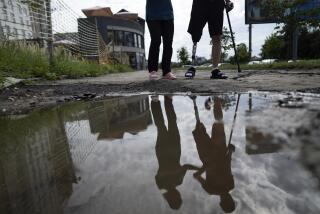Immune response, nerve growth top concerns in double arm transplant
- Share via
As Iraq war veteran Brendan Marrocco recovers from an extremely rare double arm transplant, experts in the field of reconstructive transplantation say the surgery’s ultimate success depends heavily on a patient’s immune system response and nerve tissue regeneration.
Marrocco, 26, underwent the 13-hour procedure Dec. 18 and appeared at a news conference Tuesday to answer questions with his surgeon, Dr. W.P. Andrew Lee. The procedure, which involved 16 surgeons, was performed at Johns Hopkins Hospital in Baltimore.
Marrocco’s right arm was replaced above the elbow and his left arm below the elbow. (The soldier lost both his arms and legs when his armored vehicle was struck by an explosive projectile in Baghdad in April 2009. He was the first veteran of the war to survive a quadruple amputation.)
Transplant recipients must undergo lifetime treatment with immunosuppressant drugs, as the body’s immune system responds to transplanted tissue as it would a foreign body -- by attacking it. The drugs come with a number of side effects, not the least of which is that they impair the body’s ability to combat infection. They can also boost the risk for diabetes, cancer and other illnesses.
In recent years, surgeons have begun using bone marrow infusions to modulate the body’s immune response, according to Dr. Vijay Gorantla, director of the reconstructive transplant program of University of Pittsburgh Medical Center, which pioneered the practice.
The so-called Pittsburgh protocol, which Marrocco underwent, involves taking bone marrow stem cells from the organ donor and implanting them in the recipient two weeks after the transplant surgery.
Bone marrow is where the body produces antibodies, and by introducing marrow from the donor, the recipient’s immune response is “calmed,” Gorantla said.
“The phenomonen is called clonal exhaustion and depletion,” Gorantla said. “The armies of recipient immune cells are exhausted by the overwhelming stem cells which are infused at Day 14 and then gradually deleted from the recipient immune system.”
As a result of the stem cell treatment, the patient has to take only one immunosuppressant drug instead of two or three. Gorantla said the drug used in the protocol had the added benefit of improving nerve regeneration.
Unlike a transplanted internal organ, which begins to function as soon as blood vessels are attached, transplanted hands and arms are not immediately functional. Instead, the nerves must regenerate from scratch, slowly growing from the site of the attachment, toward the fingers, at a rate of about a millimeter a day, or roughly an inch per month.
“That is the key challenge in hand transplantation,” Gorantla said. “If you don’t get that nerve to grow back, or the longer it takes for it go grow back ... the worse the outcome. The worst situation is that the patient will have a surviving hand that will be functionless.”
Transplants in which nerve cells have shorter distances to cover -- a transplant at the wrist for example -- are thought to heal more successfully.
Dr. Kodi Azari, chief of reconstructive transplantation and associate professor of surgery at the David Geffen School of Medicine at UCLA, said it can take years for a transplant recipient to gain some feeling along the entire length of the new arm.
Azari said that while recipients of hand transplants can recover 60% to 70% functionality, it is still unclear what percentage arm recipients can attain.
“This is still a very new procedure,” Azari said. “The people who’ve had it done are still getting better.”
Azari described the field of reconstructive transplantation as a new frontier in medicine, one that involved considerations never before encountered with internal organs.
For example, aesthetic concerns are nonexistent in a liver transplant. Nobody will see it.
When transplanting hands and arms though, surgeons must consider the size of the donor limb, as well as its skin color and hair pattern.
“The patient has to accept it psychologically and internalize it as their own,” Azari said of the implant. “You can imagine if you take a big man’s hand, you can’t really put that on a little petite woman. It won’t look right, they’ll never accept it as their own.”
Also, transplants like the one performed on Marrocco involve large teams of surgeons working against the clock, as blood flow cannot be introduced until the procedure is completed.
“It takes a lot of manpower to do these operations,” Azari said. “There are a lot of physicians, nurses and technicians who all have to work in concert to make sure an operation like this moves smoothly.”







